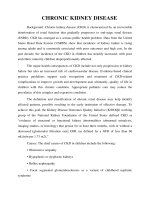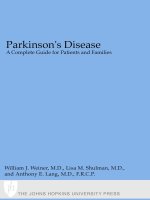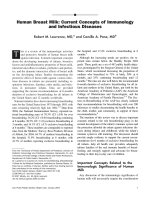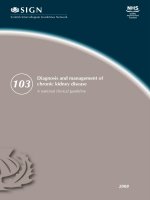Demyelinating disease
Bạn đang xem bản rút gọn của tài liệu. Xem và tải ngay bản đầy đủ của tài liệu tại đây (1.15 MB, 23 trang )
Transverse myelitis
and
spinal demyelinating diseases
•
MS is by far the most common demyelinating disease
Transverse myelitis
• inflammatory condition affecting both halves of the spinal cord and associated with rapidly progressive
motor, sensory, and autonomic dysfunction
• It affects individuals of all ages with peaks at ages 10-19 years and 30-39 years
• There is no sex or familial predisposition and usually no prior history of neurologic abnormality
Etiology
•
•
Transverse myelitis may occur in isolation or in the setting of another illness
When it occurs without apparent underlying cause, it is referred to as
idiopathic
•
Idiopathic TM is assumed to be the result of abnormal activation of the immune
system against the spinal cord
Patients with an acute short segment TM are at risk of developing MS if there is
one of the following:
• partial TM, i.e. short segment TM.
• Family history of MS. Brain lesions on MR.
• Oligoclonoal bands in CSF.
Radiographic features
• Lesions may occur anywhere within the cord, with the thoracic cord being the most frequently involved
site.
• Up to 40% of cases have no findings on MRI
• most commonly extend for 3-4 spinal segments
• More than 2/3 of the cross sectional area is involved
• Focal enlargement
• Enhancement + / -
18 years
Male
Acute paraparesis
These images are of a 31 year old male with headache, voiding
disturbances, urinary retention, sensory level C3.
The CSF analysis revealed 400/3 cells (meaning no infection)
and a slightly higher protein level.
Longitudinal case series of TM reveal that approximately 1/3 of patients recover with
little to no sequelae, 1/3 are left with moderate degree of permanent disability, and 1/3
have severe disabilities.
Multiple Sclerosis
• adolescence and the sixth decade, with a peak at approximately 35 yr
• female predilection
• The most common demyelinating
• A acquired chronic relapsing demyelinating disease
• An immune-mediated inflammatory of the brain and the spinal cord.
• Multiple lesions disseminated over time and space (multiple lesions at different times)
• CSF monoclonal bands
Radiographic features
• In MS there is typically a short segment involved, i.e. less than 2 segments.
• Partial involvement is typically seen in MS
• Location: posterior, lateral
• pathologic studies have shown that 95% of MS patients have spinal cord lesions, whether they have
spinal symptoms or not.
On transverse images MS lesions typically have a
round or triangular shape and are located
posteriorly or laterally.
This 24-year old patient had visual disturbances on one eye followed by weakness and sensory
disturbances of the lower and upper extremities a couple of years later.
Now she presents with sensory disturbances of both lower extremities.
So we already think MS
•
•
Location: infratentorial, in the deep white matter, periventricular, juxtacortical
a very early sign is called ependymal dot-dash sign (tiny (~1 mm) dots of high signal along the ependymal surface that may coalesce into short dashes
1-2
. It
presence has been reported as being very sensitive (>95%) and moderately specific (>70%) in younger individuals (<50 years of age)
•
when these propagate centrifugally along the medullary venules and arranged perpendicular to the lateral ventricles in a triangular configuration, they are
termed Dawson's fingers
•
active lesions show enhancement
The MRI of the brain shows periventricular lesions and a lesion in the corpus callosum.
These locations are very specific for MS.
Neuromyelitis Optica
• Neuromyelitis Optica (NMO) is an autoimmune demyelinating disease induced by a specific auto-antibody, the NMO-IgG.
• NMO preferentially affects the optic nerve and spinal cord.
• Brain lesions do occur and often are distinct from those seen in MS.
• like transverse myelitis, often extensive over 4 -7 vertebral segments and the full transverse diameter.
• NMO IgG is a specific biomarker for NMO.
• Female:male = 9:1
•
•
NMO presenting with neuritis optica . The brain is normal
One month later this child presented with acute transverse myelopathy
An astrocytoma could very well present with these images, but given the history of an optic neuritis and the acute myelopathy, we do not think of a tumor
This proved to be NMO and the Ig-test for NMO was positive
•
the optic neuritis and the myelopathy were simultaneously, but now we know that this is not always the case.
the location of the brain lesions in NMO is around the ventricles
The NMO IgG auto-antibodies are directed against Aquaporin-4
water-channels (highest concentration of Aquaporin-4 waterchannels is seen around the ventricles)
ADEM
• Acute disseminated encephalomyelitis (ADEM) is an inflammatory demyelinating disease of the
CNS after viral infection or vaccination.
• In 75% of patients there is a clear infectious event or vaccination (1-4 weeks)
• Typically monophasic in 90%.
• Multiphasic illness in 10%. In these cases ADEM behaves like MS and cannot be differentiated
from MS.
• Mostly seen in young children.
• In 50% of ADEM patients the anti-MOG (Myelin Oligodendrocyte Glycoprotein
positive
test is positive) IgG
• Three weeks after respiratory infection sudden onset of neurological symptoms.
• Dysarthria, dysphagia, tetraplegia.
Eye movement disturbance and impairment in consciousness.
• There is swelling and cord involvement like in TM and no enhancement
•
•
Bilateral but asymmetric
Almost deep and subcortical white matter, periventricular white matter is
generally spared
•
Thalami and basal ganglia frequently involved
Transverse myelitis
Multiple Sclerosis
Neuromyelitis Optica
ADEM
peaks at 10-19 years and 30-39 years
a peak at 35 years
average age of 41 years
younger than 15 years
rapidly progressive: over hours or days
relapsing-remitting
blindness and paraplegia,
Monophasic,
concurrently
after viral infection or vaccination
Encephalitis
long segment
short segment
long segment
Complete involvement includes both halves
Brain: Bilateral, deep and subcortical white
Complete involvement includes both halves
Partial involvement: posterior, lateral
Complete involvement includes both halves,
matter, Thalami and basal ganglia, periventricular
Brain: ependymal dot-dash sign, Dawson's
Neuromyelitis
WM spared
NMO IgG
anti-MOG IgG
fingers
Oligoclonoal bands in CSF
CSF monoclonal bands









